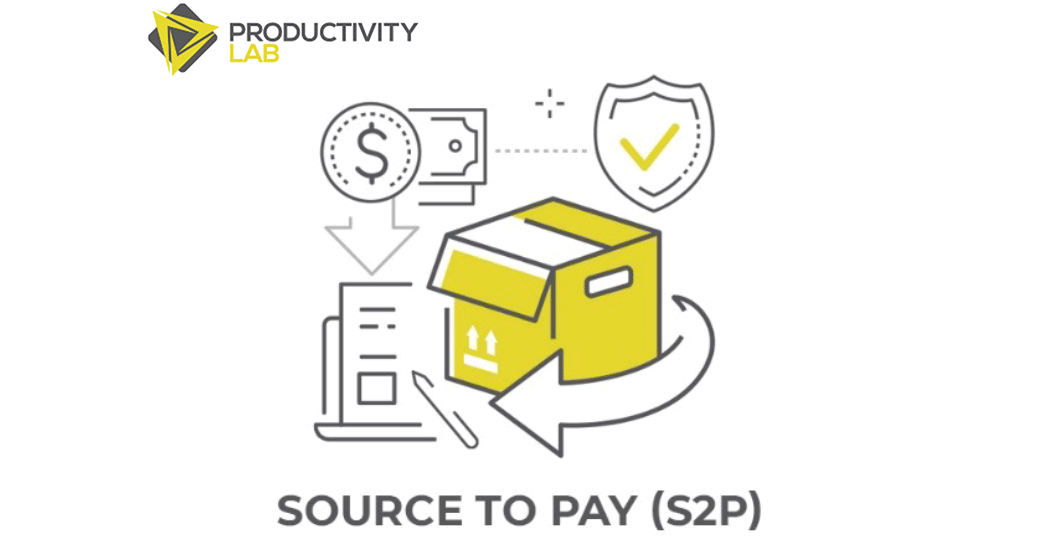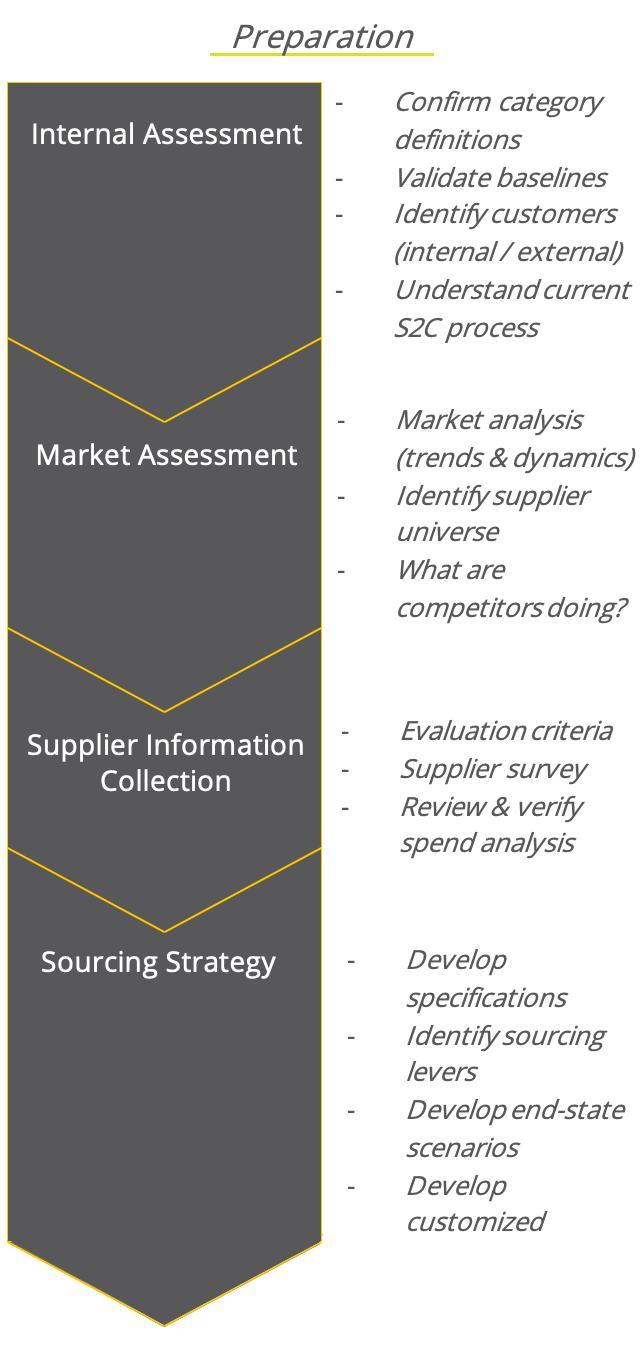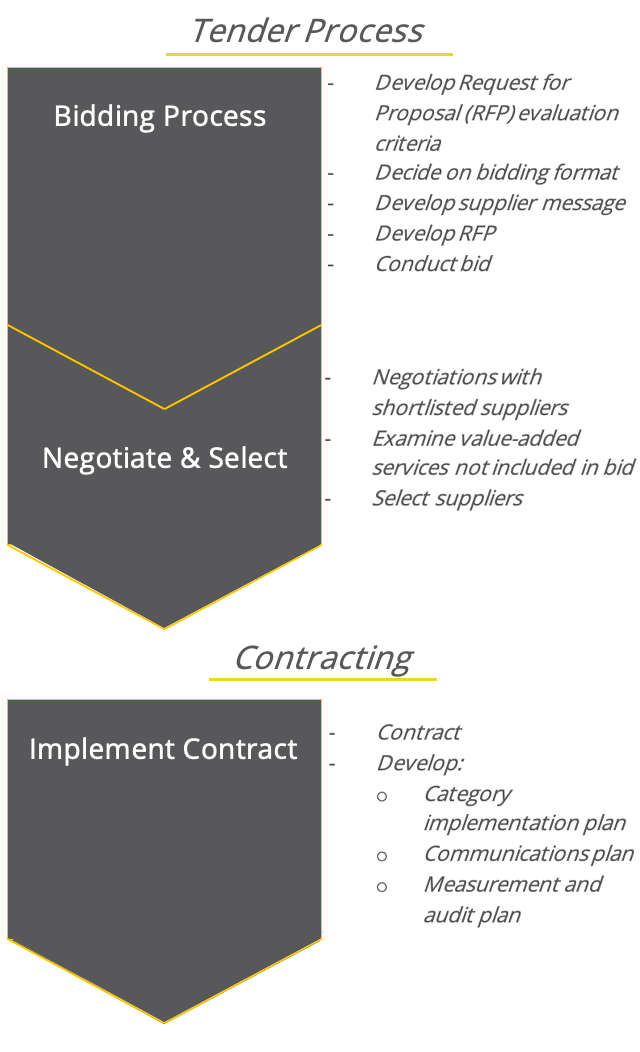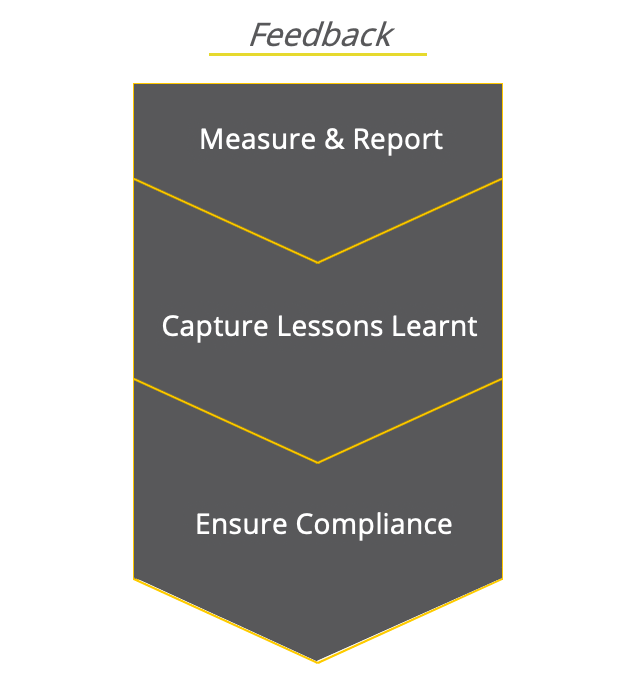
23 Dec Strategic Sourcing & Contracting
There is no question that well executed strategic sourcing frameworks and processes add value to the business, both in financial and operational terms. However, to be successful, organizations need to ensure there is adequate resources available for what can be a significant administrative burden, drive efficiency through the Source to Contract (S2C) process and ensure robust performance management frameworks are included in the final contract.
The Chartered Institute of Procurement & Supply (CIPS) defines sourcing as “…being concerned with what needs to be purchased (product / service), in what quantities, for what purpose and [from] where.”
It further adds that “Sourcing seeks to find, evaluate and engage suppliers to achieve cost savings and best value for goods and services which can be done through a tender process. Factors such as reliability, quality, flexibility and capacity are considered in the tendering process alongside price”
Major approaches to sourcing are considered to include tactical and strategic, with the most noticeable differences shown in Figure 1 below:
| Tactical Sourcing | Strategic Sourcing |
|---|---|
| Short-term view |
Longer-term view |
| Reactive in nature |
Proactive in nature |
| Transaction-focus |
Collaboration-focus |
| Price and delivery terms are key decision variables | Total Cost of Ownership (TCO) and synergies are key decision variables |
| Lower effort and intensity | Higher effort and intensity |
| Less skill required | Highly skilled activity |
Figure 1: Strategic and Tactical Sourcing
The major benefits from strategic sourcing can be summarized as:
- Cost reduction
- Supply risk mitigation
- Improved long-term supplier relationships that can lead to further cost reductions and other benefits such as boosting innovation, in the longer term
- Efficiency gains from a systematic approach
It falls naturally from Figure 1 that strategic sourcing is the ‘better’ option for an organization, but this is not a universal truth. To explore this in a bit more detail, consider the generic strategic sourcing process as in Figure 2 below. The below process is also known as the Source to Contract (or S2C) process:




Figure 2: Generic S2C process
While the generic S2C process seems (and generally is) straightforward, there is a lot of analytical and administrative work involved requiring significant manpower which in turn implies a potentially significant cost.
As part of the preparation, although not explicitly stated, many organizations will have additional work around implementing category management that builds upon spend and supplier segmentation, and these are also effort-intensive activities. Finally, the maintenance of categories, supplier and spend segmentations as well as the contracts themselves also require focused effort. Supplier management activities come in addition to these.
For clarification, it is important to keep in mind that category management is a type of procurement strategy that organizes spend into focused categories. Strategic sourcing on the other hand is as alluded to earlier, a procurement process / framework depending on where the S2C boundaries are set. For more information, on category management, check out this information from CIPS.
The extent to which strategic sourcing can be performed is therefore a trade-off between available resource (mainly human, but also to a certain extent financial), and scope of activities that can take place within a given procurement organizations, as the costs related to strategic sourcing activities can be significant.
As mentioned in Figure 1, strategic sourcing is a highly skilled activity, and if organizations don’t invest in the people that are going to execute the S2C process (hire experienced people, invest heavily in young talent or optimally, a combination of both), the process will become reactive and transactional, with tenders being executed on demand and not proactively. This would also happen if the workload outstrips the available resource.
Consider the spend segmentation shown in Figure 3 below:

Figure 3: Kraljić matrix / Purchasing Portfolio matrix (PPM)
Expanding a bit more on the different sourcing strategies from Figure 3, the full S2C process doesn’t necessarily need to be applied to all of them. In fact, for some of them, it would be a waste of time!
| Spend Type | Goal | Contract Time Frame | Approach |
|---|---|---|---|
| Strategic | Competitive advantage | Long-term | Strategic sourcing |
| Critical | availability | Long-term | Strategic sourcing |
| Leverage | Consolidate volumes to obtain best prices | Short-term / Spot | Auctions |
| Tactical | Reduce transactions costs and / or number of transactions | Spot / Short-term | Spot-buys / Procurement cards |
Figure 4: Sourcing strategies and approaches
The three first steps in the generic S2C process from Figure 2 as well as a robust spend and supplier segmentation will have to be conducted in any case to be able to arrive at the best approach for different goods and services.
Basically, it makes sense to apply strategic sourcing to high risk / high impact spend (strategic and critical spend type) as a minimum and to perhaps extend it into the low risk / high value (leverage) spend if the supplier base is expected to remain relatively constant over time. However, if there are constantly new suppliers entering these markets, it makes sense to stick to short-term contract and spot approaches.
Running an efficient S2C process is only part of the equation though. A wrong contract type or the right contract type poorly written can be costly in the long run, mainly from:
- Overpaying due to the wrong contract type
- Overpaying from not knowing enough about the work or project that is to be executed under a contract
- Resources spent in solving issues around unclarity and in the worst case, getting the other part to comply through a legal process
The most common contract types are listed in Figure 5 below:
| Contract type | Best | Potential Issues |
|---|---|---|
| Fixed price | Outsourcing or turnkey projects where the scope is near perfectly designed | Scope creep by contractors |
| Cost-reimbursable | Projects where scope is uncertain or likely to change | Scope creep by contractors, can be mitigated by setting a fee cap |
| Time and Materials | Labor contracts when risk is evenly distributed between buyer and seller | Difficult to control without a limit |
| Purchase Order | Smaller, non-critical purchases | Misunderstandings in specifications, typically not as robust as a contract in the event of non-compliance |
Figure 5: Main contract types
Picking the wrong contract type while damaging, can be largely mitigated by monitoring progress closely, as part of a contract management framework, but bear in mind that this is also resource-intensive, and may result in an overload of work.
While the full scope of a contract is not always known, it is strongly advised to spend a bit more time on the scope of work to be done in advance of contracting to avoid this potential issue.
Arguably the most damaging issue with a contract is unclear or missing performance management frameworks in contracts. An organization can execute a near perfect strategic sourcing process, only to let themselves down at the contracting stage.
There are a range of common pitfalls in procurement contracting leading to unclarity and missing salient information, the most common are listed below:
- Disconnect between stakeholders – procurement team, requesters and executors, and legal teams not working together
- Lack of appropriate tools for evaluation of bids under different scenarios – TCO calculations can be tricky, and clear methodologies and easy-to-use tools should be available. What looks like the best deal under one set of circumstances, can easily be the worst under different external conditions
- Prolonged contract negotiations leading to increased business risk and potentially a break-down in negotiations. During protracted negotiations, complex issues such as performance management frameworks tend to suffer. Sometimes, it is better to start again with a different vendor
- Performance measures are not SMART (Specific, Measurable, Attainable, Relevant, Time-bound), and / or not clearly defined leading to misunderstandings, time-wasting and a possible deterioration in the relationship with the supplier.
Finally, the importance of feedback loops as shown in Figure 2 can’t be underestimated. In the event of missing feedback loops, there is no meaningful relationship being built with the supplier, and the organizations misses out on knowledge capture that can be applied at a later date.
Almost all organization these days run some form of strategic sourcing, but to reap the maximum benefits from what is a significant effort on behalf of the organization, every part of the S2C process must be tailored to the resource available and be run at maximum efficiency with due attention being given to the contract. It really isn’t just a piece of paper!
Alan Aastorp has built capabilities and delivered performance improvements for over 20 years, including engagements with some of the world’s largest companies, as well having professional qualifications in Supply Chain Management, Finance and HR. Alan can be reached at aastorp@productivity-lab.com.
References
www.cips.org. (n.d.). Sourcing. [online] Available at: https://www.cips.org/knowledge/procurement-topics-and-skills/understand-need—market-and-options-assessment/sourcing1/sourcing/ [Accessed 20 Dec. 2021].
www.cips.org. (n.d.). Sourcing. [online] Available at: https://www.cips.org/knowledge/procurement-topics-and-skills/understand-need—market-and-options-assessment/sourcing1/.
MITxCTL.SC2x -Supply Chain Design Lecture Notes, Week 7, Module 1.
www.bellwethercorp.com. (n.d.). What’s the Difference Between Strategic and Tactical Sourcing? [online] Available at: https://www.bellwethercorp.com/whats-the-difference-between-strategic-and-tactical-sourcing/.
Dawkins, B. (2021). Four Key Strategic Sourcing Benefits. [online] QAD Blog. Available at: https://www.qad.com/blog/2021/04/four-key-strategic-sourcing-benefits.
Una. (2021). Difference Between Strategic Sourcing and Category Management. [online] Available at: https://una.com/resources/article/the-difference-between-strategic-sourcing-and-category-management/ [Accessed 20 Dec. 2021].
Concord. (2016). Procurement Contracts 101. [online] Available at: https://www.concordnow.com/blog/procurement-contracts-for-contract-management-101/.
Fagundes, L. (n.d.). How to Solve Your Biggest Procurement Contract Problems. [online] www.contractworks.com. Available at: https://www.contractworks.com/blog/how-to-solve-your-biggest-procurement-contract-problems.


